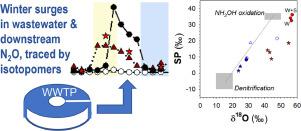Water Research ( IF 11.4 ) Pub Date : 2020-09-19 , DOI: 10.1016/j.watres.2020.116417 Yewon Chun , Dohee Kim , Shohei Hattori , Sakae Toyoda , Naohiro Yoshida , Jinhee Huh , Ju-Hee Lim , Ji-Hyung Park

|
Although eutrophic urban rivers receiving loads of wastewater represent an important anthropogenic source of N2O, little is known as to how temperature and other environmental factors affect temporal variations in N2O emissions from wastewater treatment plants (WWTPs) and downstream rivers. Two-year monitoring at a WWTP and five river sites was complemented with available water quality data, laboratory incubations, and stable isotopes in N2O and NO3− to explore how wastewater effluents interact with seasonal changes in environmental conditions to affect downstream metabolic processes and N2O emissions from the lower Han River traversing the megacity Seoul. Water quality data from four WWTPs revealed significant inverse relationships between water temperature and the concentrations or fluxes of total N (TN) in effluents. Increased TN fluxes at low temperatures concurred with N2O surges in WWTP effluents and downstream rivers, counteracting the long-term decline in TN fluxes resulting from enhanced wastewater treatments. Incubation experiments with river water and sediment, in isolation or combined, implied the hypoxic winter sediment as a large source of N2O, whereas the anoxic summer sediment produced a smaller amount of N2O only when it was added with oxic water. For both WWTP effluents and downstream rivers, bulk isotope ratios and intramolecular distribution of 15N in N2O distinctly differed between summer and winter, indicating incomplete denitrification in the hypoxic sediment at low temperatures as a primary downstream source adding to WWTP-derived N2O. Winter surges in wastewater TN and sediment N2O release highlight temperature variability as an underappreciated control over anthropogenic N2O emissions from increasingly urbanized river systems worldwide.
中文翻译:

城市化河流系统中废水和下游一氧化二氮排放的温度控制
尽管接收废水的富营养化城市河流是N 2 O的重要人为来源,但对于温度和其他环境因素如何影响废水处理厂(WWTP)和下游河流的N 2 O排放的时间变化知之甚少。两年在一个污水处理厂和五个河遗址监测与现有的水质数据,实验室孵化,并以N稳定同位素进行补充2 O和NO 3 -探索如何排放废水相互作用与环境条件的季节性变化影响到下游的代谢过程和N 2汉江下游横穿大城市首尔的O排放物。来自四个污水处理厂的水质数据表明,水温与废水中总氮(TN)的浓度或通量之间存在显着的反比关系。低温下总氮通量的增加与污水处理厂废水和下游河流中的N 2 O激增同时发生,抵消了因污水处理水平提高而造成的总氮通量的长期下降。用河水和沉积物进行的孵化实验(单独或组合)表明,低氧的冬季沉积物是N 2 O的主要来源,而缺氧的夏季沉积物产生的N 2量较少。仅当添加有氧水时才为O。对于污水处理厂废水和下游河流,夏季和冬季,N 2 O中的总同位素比和15 N在分子内的分布明显不同,表明低温下低氧沉积物中的反硝化不完全,这是添加到污水处理厂衍生的N 2的主要下游来源O.冬季废水中总氮和底泥N 2 O的释放量突显出温度变化性,因为对全球日益城市化的河流系统的人为N 2 O排放量的控制不足。











































 京公网安备 11010802027423号
京公网安备 11010802027423号